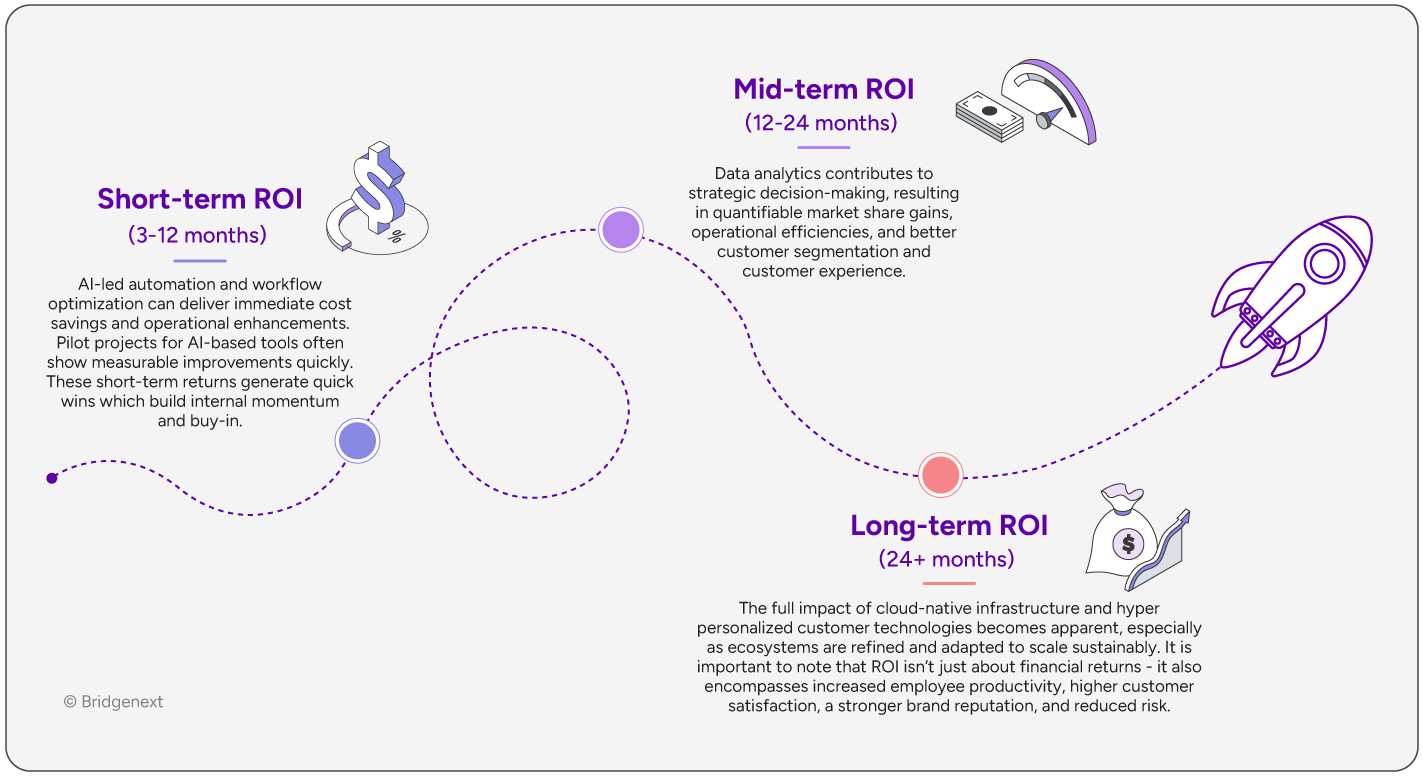01.29.25 By Bridgenext Think Tank

The role of the CIO has evolved from a technical specialist to a strategic architect of business success. Technology is no longer just the backbone of operations – it has become a powerful driver of growth, a critical differentiator, and a secret weapon for unlocking new markets and delivering exceptional customer experiences.
Welcome to 2025, a year brimming with opportunities for those prepared to invest wisely. So, where should CIOs direct their focus? Let’s explore a few of the top investment priorities and highlight examples of organizations that have successfully unlocked tangible value from these strategic investments – achieving Digital Realization.
Automation has been a cornerstone of business growth strategies, but its purpose has shifted dramatically. It’s not just about cost-savings; it’s about reaching and engaging a larger audience. In a customer-centric world, failing to meet client demands means missed opportunities. It is time to think beyond basic Robotic Process Automation (RPA) to hyperautomation which combines artificial intelligence and machine learning with intelligent workflows to create systems that don’t just execute tasks but learn, adapt, and evolve. This can be a game changer to enabling unparalleled business agility.
A French Fortune Global 500 company that specializes in digital automation and energy management implemented hyperautomation to streamline its supply chain operations. By integrating AI-driven analytics with automated workflows, the company reduced lead times by 30% and enhanced its ability to respond to market demands in real-time.
Key Strategies:
As automation enables agility, it naturally leads to the question of how organizations can use the data generated from these systems to create actionable insights. This brings us to the next priority—data.
In 2025, data is the lifeblood of innovation. But having access to data isn’t enough; the ability to analyze and act on it quickly is what sets successful organizations apart. Are you leveraging data lakes and data warehouses as part of your enterprise data strategy to manage massive flows of information? How equipped is our team to leverage that data via analysis? Looking to implement GenAI? You will need to get your data house in order first! With the right tools, advanced analytics can empower predictive decision-making and drive better outcomes.
A specialty retailer in hard-surface flooring partnered with Bridgenext to optimize its marketing ROI and overall investment strategy across 400+ stores. Using advanced retail analytics and cluster analysis, Bridgenext analyzed over 25 data sources and identified eight store clusters based on key factors like demand, competition, staffing, loyalty members, and store performance. The insights enabled the retailer to allocate resources more effectively, improve marketing spend, and streamline operations. As a result, the retailer gained a deeper understanding of its top markets, customer personas, and factors driving profitability, allowing for more informed decision-making and growth.
Key Strategies:
Data-driven insights don’t just inform internal decisions; they can also enhance customer experiences. Let’s explore how CIOs can leverage customer-centric technologies to drive engagement.
Don’t you feel wonderful when a streaming platform not only recommends your favorite genre of movies but also curates a playlist for your weekend, based on your past behavior and preferences? That’s hyper-personalization in action. Customers crave hyper-personalization. A Forbes survey found that 81% of customers prefer companies that offer a personalized experience. Generative AI and conversational AI are transforming how businesses engage with their audiences. Whether it’s personalized marketing or 24/7 support, technologies that enable personalization are no longer optional—they’re required.
A major retailer used generative AI to create personalized marketing campaigns tailored to individual shopping behaviors. For instance, they sent customized emails to customers featuring product recommendations based on their past purchases, browsing history, and seasonal trends. A frequent buyer of fitness gear received an exclusive discount on the latest running shoes, along with tips for winter workouts. Meanwhile, a home chef was sent a curated list of kitchen gadgets and recipes tailored to their cuisine preferences. This approach drove a 20% increase in customer loyalty and a 25% boost in sales.
Barnes & Noble College partnered with Bridgenext to revolutionize its email marketing strategy and improve engagement across 800+ brands. By leveraging localized content, automation, and a highly personalized approach, Bridgenext designed a dynamic email program tailored to individual campuses and audiences. As a result, Barnes & Noble College achieved a 70% increase in click-through rates, improved conversions, and now successfully distributes over one billion emails annually to a growing database of students, parents, and alumni – elevating customer engagement.
Key Strategies:
But to deliver these hyper-personalized experiences at scale, businesses need robust and resilient IT ecosystems. This is where scalability and security come into play.
As organizations grow, so do their IT ecosystems. Resilient, cloud-native architectures and infrastructure modernization are essential to remain agile and scalable. For example, imagine transitioning from a non-cloud-native offline business to launching an e-commerce platform with modernized infrastructure. By deploying containerized applications, the platform can efficiently handle traffic surges during events like Black Friday sales. At the same time, investing in AI-driven threat detection and a zero-trust security model ensures data protection, supporting scalability, resilience, and security in the face of growing demands.
A veterinary startup successfully opened 200 pet care centers within 3–5 years by embracing cloud based fully managed IT services. They achieved this feat with comprehensive solutions, including cloud infrastructure, IT governance and modernization, and fully managed services, enabled rapid technology rollouts for new facilities, seamless onboarding processes, and operational excellence. This not only streamlined their expansion but also enhanced their ability to deliver exceptional customer experiences, attract and retain clients, and meet key growth benchmarks with their funding partners.
Key Strategies:
With these priorities aligned, it’s crucial to set realistic expectations for ROI and ensure that investments are tied closely to business objectives.
The timeline for ROI can vary and depends on clear alignment between technology investments and business objectives. Here’s an approximate breakdown:

It is important to note that ROI isn’t just about financial returns—it also encompasses increased employee productivity, higher customer satisfaction, a stronger brand reputation, and reduced risk.
CIOs cannot achieve such transformational goals alone. In 2025, the complexity and pace of technological change requires collaboration both within the organization and with external partners. Internally, fostering strong partnerships across teams helps align efforts, share knowledge, and drive innovation across departmental silos. Externally, trusted partners fill gaps in specialized skills or bandwidth, enabling organizations to accelerate their digital initiatives. By leveraging expertise both inside and outside the organization, CIOs can focus on strategic priorities while ensuring seamless execution and innovation.
From getting your data in order, to generative AI or hyperautomation, Bridgenext helps you navigate the latest innovations while ensuring your IT strategy aligns with your business goals for real, measurable results. Here’s how we can support your journey:
2025 is the year to lead boldly. Connect with our Bridgenext team to help make it happen.